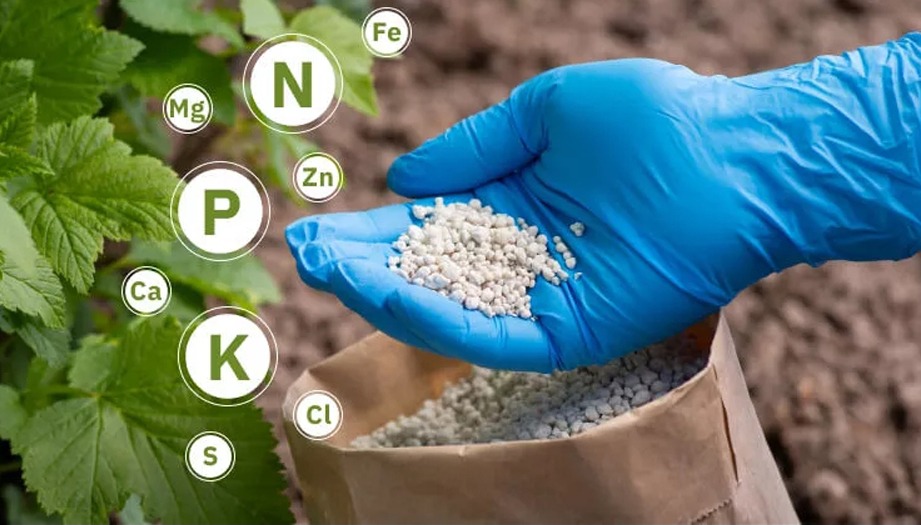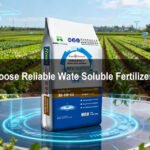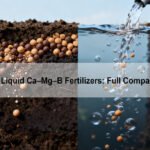Let more growers get greater benefits
Types Of Fertilizers And How To Pick The Right One
- Industry News
- August 18, 2015
- 1:55 pm
【Description】

Types Of Fertilizers And How To Pick The Right One
Fertilizers play a crucial role in ensuring that plants receive the nutrients they require for optimal growth and development. Different types of plant fertilizers are accessible to farmers, but the two most common are organic and inorganic. Nutrients in organic products are gradually released while the substance decomposes over time, while artificially synthesized inorganic products allow for the rapid uptake of nutrients by plants. However, the organic type of fertilizer is better for the soil and the ecosystem in the long run. Precision farming platforms simplify fertilizing at varying rates, maximizing the benefits of each fertilizer type.
Why Are There Different Types Of Fertilizers?
To thrive, plants require a variety of nutrients, which they get from the soil through their roots. Each harvest reduces the soil’s potential productivity unless soil nutrients are restored. The correct type of fertilizer for plants can fix nutrient deficiencies.
Fertilizers supply plants with the three essential nutrients they need to grow: nitrogen (N), phosphorus (P), and potassium (K), as well as other needed micronutrients. The key parameters of different types of fertilizers used in agriculture are these nutrients and how they are obtained. Many factors, including soil quality, crop type, and application method, can influence fertilizer type decisions. There is a wide variety of fertilizing products available today, allowing farmers to create a nutrient-rich environment for their crops.
Inorganic Type Of Fertilizers
Inorganic, or synthetic, fertilizers are chemical substances manufactured from natural-origin elements. Their main goal is to fulfill plant macronutrient requirements. Inorganic fertilizer type has the advantages of being economical, simple to use, and readily accessible to plants. Unfortunately, its natural acidity often kills off helpful microorganisms and makes the environment hostile to other forms of life. Moreover, overfertilizing with synthetics contributes to environmental pollution and global warming. Now, let’s delve deeper into different types of synthetic fertilizers.
Nitrogen (N) Fertilizer Type
N-fertilizers are especially useful in the middle phases of a plant’s life cycle, when the plant needs the most support to keep growing and leafing out. The two most popular types of chemical nitrogen-based fertilizer in European fields are ammonium nitrate (AN), aka nitric acid, and calcium ammonium nitrate (CAN). With its dual-form nitrogen content, AN works well for crops that need fast nitrogen release. Outside of Europe, urea, along with urea ammonium nitrate (UAN) solution in water, is frequently applied. Urea’s versatility and high nitrogen concentration (minimum 44%) make it a common N-based product .
Although most plants need the nitrogen type of fertilizer to thrive, too much of it can cause fertilizer burn, which might result in discolored leaves and even plant death. To prevent this, only apply nitrogen-rich feeding to your plants when they are actively growing and at a rate smaller than suggested on the label.
Nitrogen fertilizer type must be applied at the start of the season and sometimes throughout, depending on the crop. To apply N-fertilizer at a variable rate, farmers need to be aware of the current field’s condition and vegetation density. For this purpose, EOSDA Crop Monitoring builds vegetation maps by using the most recent cloud-free images and segmenting the field into zones based on a specified vegetation index. The NDRE index should be used to build a fertilizing map in the middle and late phases of the growing season, whereas the MSAVI index should be used at the beginning of the season (when the soil is still somewhat bare). The normalized difference vegetation index (NDVI) is applicable year-round.
Mono Ammonium Phosphate Map Fertilizer 11-44 -0 Granular
Phosphorus (P) Fertilizer Type
Phosphorus feeding, which serves to reinforce roots and stems, is crucial at all stages of the plant’s growth cycle. The phosphorus type of fertilizer also boosts reproductive success, including flowering, seed production, and fruit set. Phosphorus-based feeding, in contrast to nitrogen-based feeding, has difficulty penetrating plant tissues beyond the root zone. To maintain a constant P supply throughout the season, many farmers opt for a slow-release method. Because of its delayed action and lengthy duration, phosphorus fertilization is best applied before planting.
P-fertilizers come in a wide variety of chemical and physical forms. Single superphosphate (SSP), triple superphosphate (TSP), diammonium phosphate (DAP), ammonium dihydrogen phosphate (ADP), and ammonium polyphosphate (APP) liquid are the most widely used types of P-fertilizer.
Potassium (K) Fertilizer Type
Potassium-based fertilizer will promote robust root development in your plants. This type of synthetic fertilizer can serve as a buffer for your plants if they are deficient in other nutrients. Fertilizing with potassium-based products also helps plants maintain healthy photosynthesis and limits the spread of diseases. Apply this type of chemical as close to the plant’s roots as you can.
Some examples of potash type fertilizers are potassium chloride (KCl), potassium sulfate/sulfate of potash (K2SO4), and potassium nitrate (KNO3). These products may also include additional minerals.
Using the EOSDA Crop Monitoring platform’s productivity maps, you can precisely apply phosphorus and potassium fertilizers. Since they tend to stay in the soil for longer, you can apply them less frequently than N-fertilizers (depending on crop type, soil composition, and climatic conditions).
Due to the long-lasting nature of these fertilizing substances, it is also important to perform field analysis over a longer time frame. By evaluating satellite imagery captured over several years, our algorithm determines which areas of a field have higher and lower productivity. Leverage this data to maximize the cost-effectiveness of soil testing by locating sampling zones, estimate the potential savings from VRA (variable rate application) vs. an even rate application, and apply phosphorus and potassium types of fertilizers in a targeted manner.
Compound (NPK) Fertilizer Type
Fertilizers that contain varying levels of N, P, and K are known as compound ones. There are different types of NPK fertilizers used in agriculture, depending on nutrient formulations, and each is typically designed to fulfill the needs of a particular crop grown in a particular soil type. Most plants and soil types can benefit from a fertilizing product with an NPK ratio of 10-10-10. Soil types that don’t keep nutrients well, like sandy or clay, may call for fertilizing with a higher NPK level, like 15-15-15.
Sulfur, Magnesium, And Calcium Fertilizer Types
Secondary nutrients like sulfur (S), magnesium (Mg), and calcium (Ca) are rarely used separately but rather mixed with the essential-nutrient fertilizing products. Sulfur is commonly included in N-fertilizers like nitric acid and urea. Additional types of sulfur fertilizers include single superphosphate (SSP), sulfate of potash (SOP), and potassium magnesium sulfate (PMS). Kieserite (magnesium sulfate monohydrate) is a popular Mg-based fertilizer. Calcium nitrate is a widely accessible calcium-based plant nutrition. Lime (calcium carbonate) and gypsum (calcium sulfate) can also be used to amend the soil with calcium.
Micronutrient Fertilizer Type
A micronutrient type of fertilizer includes nutrients crucial for plant growth but only needed in trace amounts: iron (Fe), manganese (Mn), molybdenum (Mo), boron (B), zinc (Zn), chlorine (Cl), and copper (Cu). Since micronutrients are required in trace amounts, foliar fertilization is typically the most effective way to address a micronutrient shortage. Micronutrients are often blended with fertilizing products of N, P, and/or K.
The following table summarizes the function of each nutrient that can be found in various types of fertilizers used in agriculture.
Organic Type Of Fertilizers
Organic fertilizing products often consist of a single component, making them easy to tailor to a plant’s unique nutrient requirements. You can side-dress or incorporate into the soil different types of natural fertilizers derived from plants, minerals, and animal sources. The two main types of organic fertilizers are:
- plant-based: alfalfa and cottonseed meal, liquid kelp and kelp meal, compost and compost tea, molasses, and cover crops;
- animal-based: manure and manure tea, bone and blood meal, urea, fish emulsion, milk, etc.
When used appropriately, these products provide the crops with an abundance of macro-, micro-, and trace nutrients. Beyond that, they help create an environment where beneficial bacteria, fungi, and insects can thrive. This could be the earthworms responsible for aerating the soil, increasing its drainage capacity, and bringing organic matter down to the subsurface, where most plants’ roots can reach it.
Farmers employing natural types of fertilizers for plants should be aware that they take longer to decompose but yield better results in the long run. For crops that require a rapid boost, natural liquid feedings can be helpful, but they don’t last very long.
Slow-Release Fertilizer Type
Basically, by slow-release type of farm fertilizers, we mean a nutrient core with a synthetic resin or sulfur-containing polymer coating that degrades over time when exposed to moisture, heat, light, and/or soil microorganisms. Most of these fertilizing products feature controlled- or sustained-release components. The purpose of the slow-release fertilizer type is to nourish plants with nutrients over a longer period. For instance, studies have shown that even in poor climatic conditions like drought, it makes sense to supplement larger N dosages using some slow-release fertilizing products .
Forms Of Fertilizing Products
Fertilizing products are available in three main forms: liquid, soluble powder, and granular. Liquid-form feeding is frequently watered down, and, like irrigating a field, spreading it may take a hose attachment. For the best result, it’s recommended to employ fertigation systems. Powdered dry fertilizer type also requires water to work. In most cases, the feeding product is broadcast and watered thoroughly until it is absorbed. Granular types of fertilizers are very practical for top-dressing fields. As the soil is moistened, the granules will progressively break down.
Each form has its own nuances of application. Liquid type of fertilizer is fast-acting, but it may come with a heavy price tag and can be tricky to apply uniformly. Granular nourishment is simpler to apply uniformly, but plants won’t absorb its nutrients as quickly.
How To Choose The Right Type Of Fertilizer
Choosing the right type of plant fertilizer depends on several factors, including the type of cultivated crops, the soil condition, and the specific nutrient needs at different environmental conditions and plant growth stages. Here are some steps to help you determine the best type of commercial fertilizer:
- Conduct soil testing to identify any nutrient deficiencies or excesses.
- Find out the specific nutrient requirements of your crops at the given stage of their growth.
- Choose a fertilizer type with an NPK ratio that matches the needs of your crops. Some plants, like leafy greens, thrive with more nitrogen, while others, like flowers, might benefit from more phosphorus.
- Be cautious of the environmental impact of the fertilizers you choose. In terms of both greenhouse gas emissions and water pollution, synthetic N-fertilizers stand out as particularly harmful.
Finally, remember that, even with the right type of fertilizer for your crops, the right dosage is essential. By applying just the proper amount, you can prevent soil salinization, leaching, and other detrimental effects of overfertilizing. Today’s agricultural technology makes precise fertilization a breeze. In the long run, yields and the environment will both gain from this.
TRENDING
TAIAN RISSO CHEMICAL FERTILIZER CO.,LTD
- Address: High-tech Development Zone, Taian City, Shandong Province
© Copyright 2017 RISSO CHEMICAL. All Rights Reserved.







